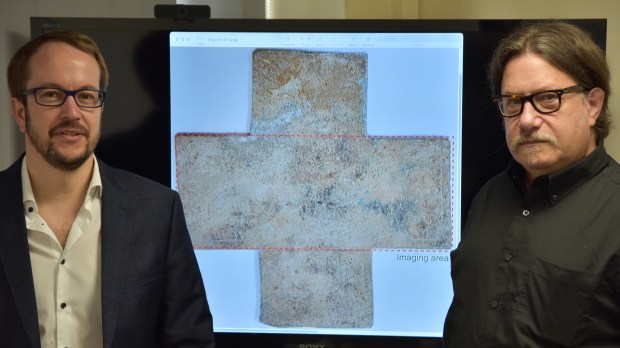Experts analyzing a French funerary cross have been able to peer underneath centuries of corrosion to reveal its original inscription. Using a technology called terahertz imaging, they were able to observe a clear picture of the Lord’s Prayer, written in Latin. The team suggested that the technology they employed could be a boon to subsequent analyses of historical artifacts.
The work was conducted by an interdisciplinary team of scientists from Georgia Institute of Technology, in conjunction with Georgia Tech-Lorraine. They explained in a report from Georgia Tech that terahertz imaging was selected as a means of analysis due to its non-destructive nature. This was especially important, considering how delicate the cross had become.
The lead cross is an example of a “croix d’absolution,” a medieval funerary cross that was common in France, Germany, and England in the 16th century. Aurélien Vacheret, director of Musée Charles-de-Bruyères, the museum that loaned the cross to Georgia Tech, explained its function:
“This type of cross typically bears inscriptions of prayers or information about the deceased. It is thought their purpose was to seek a person’s absolution from sin, facilitating their passage to heaven.”
Terahertz imaging
The process of terahertz analysis began by subjecting the cross to short bursts of terahertz electromagnetic radiation, which travels on tiny waves of light. Some of these light waves bounce off the corrosive layer, but others can penetrate it. The team then measures the differences in the time it takes for the light waves to bounce back in order to determine the thickness of the corrosive layer.
The penetrating waves are the most decisive in determining what the lead under the corrosion looks like. When they return to the scanner, they bear images of the lead, which can be collected to form a full picture. The process is very tedious and the team had to take another image every 50 microns (about half a millimeter).
The result of the analysis revealed a surprisingly legible inscription of the Pater Noster, the Latin form of the Lord’s Prayer. What’s more, the terahertz images showed parts of the inscription that would not be seen by the naked eye. The team was able to confirm this when they removed the corrosive layer during restoration.
Professor David Citrin, leader of the project, told Georgia Tech:
“In this case, we were able to check our work afterwards, but not all lead objects can be treated this way,” Citrin said. “Some objects are large, some must remain in situ, and some are just too delicate. We hope our work opens up the study of other lead objects that might also yield secrets lying underneath corrosion.”
Citrin’s team has previously utilized terahertz imaging on 17th-century paintings, and is currently helping analyze ancient Roman pottery. He noted that terahertz imaging is continuing to develop, but it carries enormous potential to document some of the most delicate archaeological finds.

